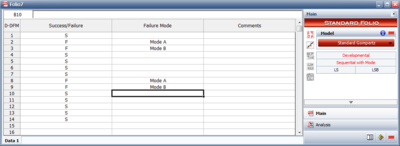Template:Discrete data
Discrete Data
Discrete data is also referred to as success/failure or attribute data. It involves recording data from a test for a unit when there are only two possible outcomes: success or failure. An example of this is a missile that gets fired once and it either succeeds or fails. The data types available for analyzing discrete data with the RGA software are:
• Sequential
• Sequential with Mode
• Grouped per Configuration
• Mixed Data
Sequential Data
For Sequential data, an item is tested with only two possible outcomes: success or failure. This could be a one-shot item such as a missile or an entire system that either succeeds or fails. The item is then inspected after each trial and redesigned/repaired before the next trial. Figure Sequential shows an example of this data type, where the row number in the data sheet represents the sequence of the trials. In this data set, trial #1 succeeded, trial #2 failed, and so on.
Sequential with Mode Data
Often after failure analysis you know the reason for failure during a particular trial. If this is the case, the reason for each failure can also be used in the analysis. This data entry is identical to the Sequential data with the exception that a failure code, mode or ID is added after each failure so that the analysis can take into account different failure modes. Figure SequentialMode shows an example of this type of data.
Grouped per Configuration Data
This data type is used when multiple items, instead of a single item, are tested and the number of units that fail are recorded for each configuration. The row numbers that appear on the left side of the Data Entry Spreadsheet, shown in Figure GroupConfig, represent the unique configurations. For example, row 1 indicates configuration 1 in which 10 missiles were fired and 5 failed, row 2 indicates configuration 2 in which 8 missiles were fired and 3 failed, etc. The data can be cumulative or non-cumulative.



Mixed Data
The mixed data type can have input data that is either configuration in groups or individual trial by trial, or a mixed combination of individual trials and configurations of more than one trial. Figure Mixed data shows an example of this data type. For example the first row of this data sheet shows that three failures occurred in the first four trials, the second row shows that there was no failure in the next trial while the third row shows that three failures occured in the next four trials

Models for Discrete Data
The following models can be used to analyze discrete data. Models and examples using the different data types are discussed in later chapters.
1) Duane (Chapter 4)
2) Crow-AMSAA (NHPP) (Chapter 5)
3) Crow Extended (Chapter 9)
4) Lloyd-Lipow (Chapter 6)
5) Gompertz and Modified Gompertz (Chapter 7)
6) Logistic (Chapter 8)